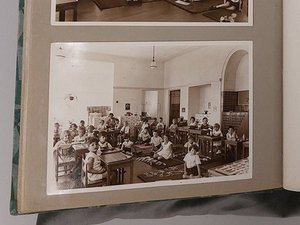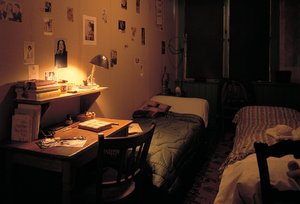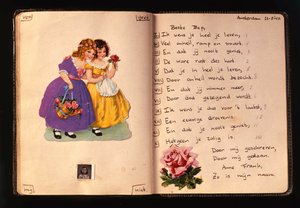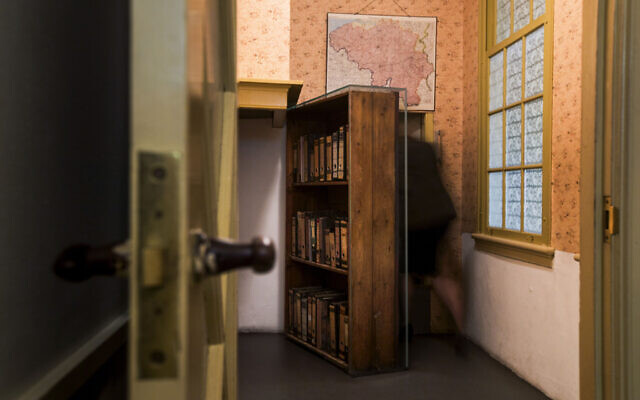|
Getting your Trinity Audio player ready...
|
NYC to Host the First Full-Scale Re-Creation of Anne Frank’s Secret Amsterdam Annex
Edited by: Fern Sidman
Starting in January 2025, visitors to New York City will have the extraordinary opportunity to experience a profoundly significant moment in history: the haunting atmosphere of the secret annex where Anne Frank wrote her world-famous diary during World War II. According to a report in The New York Times, the Anne Frank House in Amsterdam, which houses the original annex where Anne, her family, and four other Jews hid from the Nazis, will announce the opening of “Anne Frank the Exhibition” on Wednesday. This will be the first time a full-scale replica of the secret annex will be exhibited outside the Netherlands.
The exhibition, a collaboration between the Anne Frank House and the Center for Jewish History, will open to the public on January 27, 2025—International Holocaust Remembrance Day—at the Center for Jewish History on Union Square in Manhattan. Running through April 30, 2025, the exhibit will allow visitors to walk through carefully recreated spaces that replicate the rooms Anne Frank and the others inhabited from July 1942 until August 1944, when they were tragically discovered by the Nazis, according to the information provided in The New York Times report. Anne Frank, only 15 years old at the time, was later sent to Bergen-Belsen concentration camp, where she perished. Her father, Otto Frank, was the only member of the family to survive.
As Ronald Leopold, the executive director of the Anne Frank House explained in an interview with The New York Times, the museum in Amsterdam is one of Europe’s most visited historical sites, drawing about 1.2 million visitors each year. However, the New York Times report indicated that he acknowledged that many people around the world may never have the chance to visit the museum in person. “We do realize that so many more people do not have the opportunity to travel to Amsterdam,” Leopold said. The New York exhibition, he added, offers those people a unique opportunity to connect with Anne Frank’s story and experience an emotional impact similar to that felt by visitors in Amsterdam.

Though the New York installation will closely mirror the original annex, The New York Times notes one key difference. While the Amsterdam annex remains empty, honoring Otto Frank’s wish to preserve the space as a symbol of absence, the New York re-creation will take a different approach. It will be furnished to reflect a “lived-in” feeling, featuring some of the Frank family’s own belongings recovered by Otto after the war. As The New York Times report emphasized, this touch of authenticity will lend a more personal and emotional dimension to the exhibition, helping visitors imagine the daily lives of Anne Frank and her family as they endured their two years in hiding.

In July 1942, Anne Frank (13), her parents, Otto and Edith Frank, and her sister, Margo Frank (16), went into hiding in the annex at the back of her father’s company. The Van Pels family (Hermann, Auguste, and their 15-year-old son, Peter) followed the next week. Four months later, they were joined by Fritz Pfeffer. All of them were Jews daring to escape certain death at the hands of the Nazis amid the German occupation of the Netherlands during World War II. Unable to go to school, largely cut off from the rest of the world, and trapped in close quarters with others while a war raged outside, Anne poured herself into her diary. The people in hiding in the Annex were discovered in 1944, and Anne and the others were arrested and sent to the Auschwitz-Birkenau concentration and extermination camp. Anne and her sister Margot were then sent to the Bergen-Belsen concentration camp, where they both died of typhus in February 1945. Anne was 15. Margot was 18 or 19. Otto Frank was the only person from the Annex to survive the Holocaust.
“We feel that this will bring audiences who are not necessarily familiar with the story closer to that history and closer to Anne Frank,” Leopold said in an interview with The New York Times.
Dr. Gavriel Rosenfeld, President of the Center for Jewish History, said: “We are absolutely thrilled to partner with the Anne Frank House on this landmark exhibition. As we approach the 80th anniversary of the liberation of Auschwitz in January, Anne Frank’s story becomes more urgent than ever. In a time of rising anti-Semitism, her diary serves as both a warning and a call to action, reminding us of the devastating impact of hatred. This exhibition challenges us to confront these dangers head-on and honor the memory of those lost in the Holocaust.”

Anne Frank: The Diary of a Young Girl, more commonly known as The Diary of Anne Frank, is one of the most translated books in the world. Transformed multiple times for stage and screen, the published book’s source is the personal diary that Anne Frank kept in multiple notebooks during the two-year period of hiding with her family in rooms located in the back house of her father’s company in Amsterdam. Soon after Anne and the others were arrested in 1944, Miep Gies, one of the people who risked their lives to help them in hiding, returned to the annex and found their belongings ransacked.
Miep was relieved to find Anne’s diary pages, knowing how important her writings were to her, and saved them for her return. Otto was the only person from the annex to survive the Holocaust. When Miep first gave him his daughter’s diary, he could not bring himself to read it. Soon, he did and he could not stop, sharing it with relatives and friends who encouraged him to publish what they considered “an important human document.” Upon its publication, Otto Frank wrote: “How proud Anne would have been if she had lived to see this. After all, on March 29, 1944, she wrote: ‘Imagine how interesting it would be if I published a novel about Secret Annex.'”
The exhibition is expected to attract large crowds, and tickets are already available for purchase online, The New York Times report noted. This groundbreaking installation offers a chance to step into history, to grasp the humanity behind one of the most poignant narratives of the Holocaust, and to remember the millions of lives affected by the atrocities of that time. Through the replication of the annex and the inclusion of personal artifacts, the exhibition will stand as a powerful tribute to Anne Frank’s legacy and her enduring message of hope amidst darkness.
The New York re-creation will also offer enhanced accessibility. Unlike the original annex, which spans several floors, the exhibition will occupy a single level, with nonfunctioning staircases marking the different floors of the actual hiding place. This will allow all visitors to experience the space while maintaining historical accuracy. The New York Times emphasized that this thoughtful design will offer new ways for visitors to connect with the story.
The Anne Frank House was established in 1957 in cooperation with Otto Frank, Anne Frank’s father, as an independent nonprofit organization entrusted with the preservation of the Annex where Anne Frank and her family went into hiding in 1942 during the Second World War. The Annex is where Anne wrote her diary, and where she and her family hid from the Nazis during the occupation of the Netherlands until being discovered and arrested by police officers in 1944.
For nearly seven decades, the Anne Frank House has served as a place of memory and a place of learning. Committed to bringing Anne’s life story to world audiences, the Anne Frank House has emerged as a primary resource for teaching and learning about the Holocaust. Through Anne’s legacy the Anne Frank House empowers people of all ages—and especially young people—to reflect on the dangers of anti-Semitism, racism, and discrimination and the importance of freedom, equal rights, and democracy.
Spanning 7,500 square feet, the exhibition will explore not only Anne Frank’s time in the annex but also her early life in Frankfurt, the rise of the Third Reich, and Otto Frank’s postwar years. As The New York Times report explained, the multimedia elements will create a dynamic experience, including a floor-to-ceiling representation of life in Amsterdam in 1941 and a lighted glass floor pinpointing Holocaust-era mass killing sites. While the exhibition’s design could be adapted for future venues, The New York Times notes that there are currently no plans for the show to travel.
Among the exhibition’s many artifacts are more than 100 original items, some of which have never before been displayed in the United States. These include Anne Frank’s first photo album and a poetry journal belonging to her best friend, in which Anne herself contributed an original poem. Although Anne Frank’s handwritten diary will remain in Amsterdam, published editions will be available for viewing. As The New York Times highlights, the exhibit will even include a meaningful New York connection—postwar correspondence between Otto Frank and students at a Bronx school.
“We know how important and relevant this history is, regardless of who you are,” Leopold told The New York Times. This exhibition, rich in personal artifacts and emotional resonance, serves as a profound reminder of the Holocaust’s impact and Anne Frank’s enduring legacy. By bringing Anne’s story to new audiences in New York, the exhibition aims to foster a deeper understanding of history and a lasting connection to one of the most powerful accounts of human endurance in the face of unspeakable tragedy.
The exhibit will be presented at Center for Jewish History located at 15 West 16th Street, New York, N.Y. between 5th and 6th Avenues in the Union Square neighborhood of Manhattan. The exhibit will be open from Sunday through Thursday: 9:30 a.m. to 7:30 p.m. and on Friday: 9:30 a.m. to 3:30 p.m. It is closed on Saturday. Tickets will be available at AnneFrankExhibit.org. The exhibition is designed for children (ages 10 and older) and adults. All general admission tickets include the exhibition audio guide. Visitors should plan to spend approximately one hour at the exhibition. Last entry is one hour before closing.




